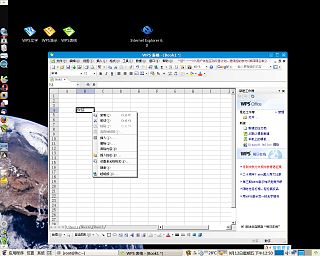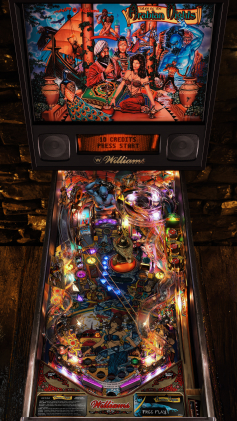
UAE is a computer emulator which emulates the hardware of Commodore International's Amiga range of computers. Released under the GNU General Public License, UAE is free software.

MAME is a free and open-source emulator designed to recreate the hardware of arcade games, video game consoles, old computers and other systems in software on modern personal computers and other platforms. Its intention is to preserve gaming history by preventing vintage video games from being lost or forgotten. It does this by emulating the inner workings of the emulated machines; the ability to actually play the video games is considered "a nice side effect". Joystiq has listed MAME as an application that every Windows and Mac gamer should have.
In software engineering, a compatibility layer is an interface that allows binaries for a legacy or foreign system to run on a host system. This translates system calls for the foreign system into native system calls for the host system. With some libraries for the foreign system, this will often be sufficient to run foreign binaries on the host system. A hardware compatibility layer consists of tools that allow hardware emulation.

A ROM image, or ROM file, is a computer file which contains a copy of the data from a read-only memory chip, often from a video game cartridge, or used to contain a computer's firmware, or from an arcade game's main board. The term is frequently used in the context of emulation, whereby older games or firmware are copied to ROM files on modern computers and can, using a piece of software known as an emulator, be run on a different device than which they were designed for. ROM burners are used to copy ROM images to hardware, such as ROM cartridges, or ROM chips, for debugging and QA testing.

NESticle is a Nintendo Entertainment System emulator, which was written by Icer Addis of Bloodlust Software. Released on April 3, 1997, the widely popular program originally ran under MS-DOS and Windows 95. It was the first freeware NES emulator, and became commonly considered the NES emulator of choice for the 1990s. Initially offering few features and only supporting a handful of games, development proceeded rapidly and to expand usability such that NESticle is today credited with introducing the concept of recordable playthrough for emulation, as well as providing the capacity for users to create their own graphical hacks via an integrated graphics editor. In pioneering this heightened level of access for users, and providing the tools for fans to hack and remix familiar classics, NESticle has been credited by Spin as representing a milestone toward the development of video game music as a genre.
Multi Emulator Super System (MESS) was an emulator for various consoles and computer systems, based on the MAME core. It used to be a standalone program, but is now integrated into MAME . MESS emulated portable and console gaming systems, computer platforms, and calculators. The project strived for accuracy and portability and therefore was not always the fastest emulator for any one particular system. Its accuracy made it also useful for homebrew game development.

The Gravis UltraSound or GUS is a sound card for the IBM PC compatible system platform, made by Canada-based Advanced Gravis Computer Technology Ltd. It was very popular in the demoscene during the 1990s.

Basilisk II is an emulator which emulates Apple Macintosh computers based on the Motorola 68000 series. The software is cross-platform and can be used on a variety of operating systems.

The Quick Emulator (QEMU) is a free and open-source emulator that uses dynamic binary translation to emulate a computer's processor; that is, it translates the emulated binary codes to an equivalent binary format which is executed by the machine. It provides a variety of hardware and device models for the virtual machine, enabling it to run different guest operating systems. QEMU can be used with a Kernel-based Virtual Machine (KVM) to emulate hardware at near-native speeds. Additionally, it supports user-level processes, allowing applications compiled for one processor architecture to run on another.
This article provides basic comparisons for notable text editors. More feature details for text editors are available from the Category of text editor features and from the individual products' articles. This article may not be up-to-date or necessarily all-inclusive.

Project64 is a free and open-source Nintendo 64 emulator written in the programming languages C and C++ for Microsoft Windows. This software uses a plug-in system allowing third-party groups to use their own plug-ins to implement specific components. Project64 can play Nintendo 64 games on a computer reading ROM images, either dumped from the read-only memory of a Nintendo 64 ROM cartridge or created directly on the computer as homebrew.
UltraPin is a Multi-Game pinball arcade game that holds 12 digital recreations of Williams Electronics real pinball games in a single pinball cabinet. UltraPin is built in a traditional style pinball cabinet to look and feel like a real pinball machine. It has two LCD screens, a 19 inch LCD for the back glass and DMD, and a 32 inch LCD for the playfield, and it uses Windows XP Embedded for its operating system.

Higan is a free and open source emulator for multiple video game consoles, including the Super Nintendo Entertainment System. It was developed by Near. Originally called bsnes, the emulator is notable for attempting to emulate the original hardware as accurately as possible through low-level, cycle-accurate emulation and for the associated historical preservation efforts of the Super NES platform.

A video game console emulator is a type of emulator that allows a computing device to emulate a video game console's hardware and play its games on the emulating platform. More often than not, emulators carry additional features that surpass limitations of the original hardware, such as broader controller compatibility, timescale control, easier access to memory modifications, and unlocking of gameplay features. Emulators are also a useful tool in the development process of homebrew demos and the creation of new games for older, discontinued, or rare consoles.
Future Pinball ("FP") is a freeware 3D pinball editing and gaming application for Microsoft Windows. It is similar to Visual Pinball ("VP") and other modern pinball simulation applications. Just as with VP's partnership with Visual PinMAME, FP uses partner applications to emulate original pinball ROM code. In FP's case, the end results of ROM code are simulated by Better Arcade Mode ("BAM") and tools such as "Pinball Browser" and dot-matrix display software plugins. Core FP development was discontinued in 2010, but resumed in 2013 via BAM. BAM features many new developments, such as enhanced physics, optics, and virtual reality support.

Mednafen, formerly known as Nintencer, is an OpenGL and SDL multi-system free software wrapper that bundles various original and third-party emulation cores into a single package, and is driven by command-line input. It is distributed under the terms of the GPL-2.0-or-later license. Certain emulation cores of Mednafen have been ported to RetroArch/Libretro.

OpenEmu is an open-source multi-system video game emulator designed for macOS. It provides a plugin interface to emulate numerous consoles' hardware, such as the Nintendo Entertainment System, Genesis, Game Boy, and many more. The architecture allows for other developers to add new cores to the base system without the need to account for specific macOS APIs.

Longene is a Linux-based operating system kernel intended to be binary compatible with application software and device drivers made for Microsoft Windows and Linux. As of 1.0-rc2, it consists of a Linux kernel module implementing aspects of the Windows kernel and a modified Wine distribution designed to take advantage of the more native interface. Longene is written in the C programming language and is free and open source software. It is licensed under the terms of the GNU General Public License version 2 (GPLv2).















